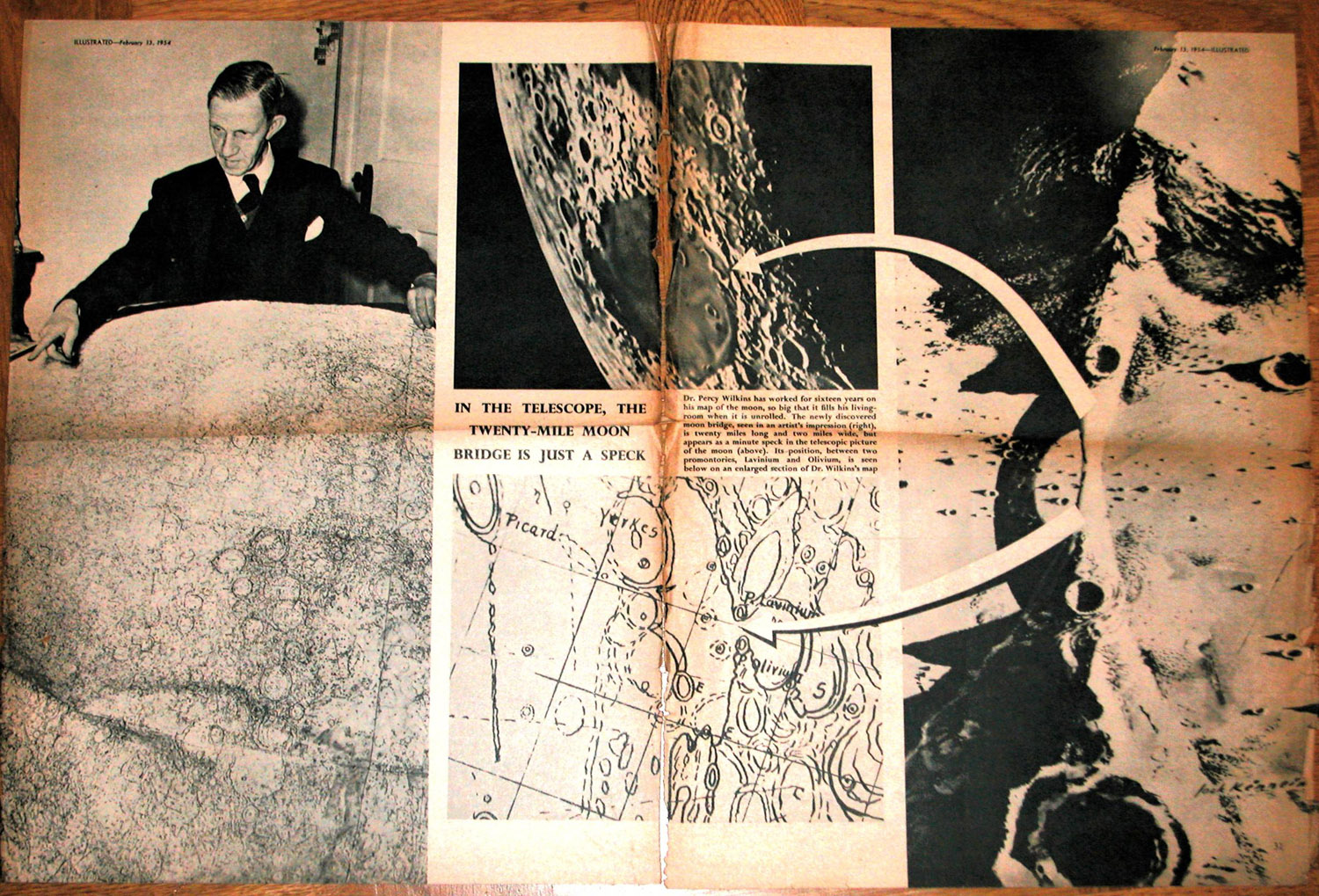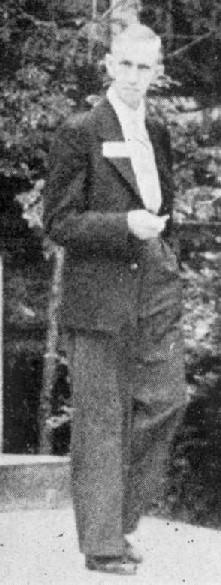Hugh Percy Wilkins
Contents
Hugh Percy Wilkins
(Lunar scientist)Table of Contents
[#Hugh Percy Wilkins Hugh Percy Wilkins]
[#Hugh Percy Wilkins-Lunar Work Lunar Work]
[#Hugh Percy Wilkins-Where & When Where & When]
[#Hugh Percy Wilkins-Personal Information Personal Information]
[#Hugh Percy Wilkins-Personal Information-Photo Photo]
[#Hugh Percy Wilkins-Personal Information-Birth Birth]
[#Hugh Percy Wilkins-Personal Information-Death Death]
[#Hugh Percy Wilkins-Personal Information-Education Education]
[#Hugh Percy Wilkins-Publications Publications]
[#Hugh Percy Wilkins-Additional Information Additional Information]
[#Hugh Percy Wilkins-Bibliography Bibliography]
Hugh Percy Wilkins is most noted for his efforts as an amateur astronomer, particularly as a selenographer. He was elected to the [/BAA British Astronomical Association] in 1918 and served as Director of the Lunar Section from 1946-1956. He is probably best known for the classic [/Wilkins%20and%20Moore observing guide] he wrote with Patrick Moore.
Lunar Work
- Wilkins produced a number of lunar maps, beginning with a 60-inch map published in 1924. This was followed in 1930 by a 200-inch map, in quadrants, that was also printed in reduced size as a single image 30 inches in diameter. He then commenced work on his 300-inch map, which first appeared in 1946, with revised versions issued in 1951 and 1954. [/Wilkins%20and%20Moore Wilkins and Moore] reproduces the 300-inch map in reduced-size sections. This map was considered by some as the culmination of the art of selenography prior to the space age. However Wilkins' maps were dense with detail, some of which was fictitious, making them less useful than most.
- Scans of a reduced size edition of Wilkins' 300-inch map published by [/ALPO ALPO] as a special supplement to their Strolling Astronomer in the 1950's are available at reduced resolution on the Astronomical Society of Las Cruces website
- Wilkins' official 1951 3rd Edition (at a scale of 100-inches to the lunar diameter) is available at half size, as well as later details of 14 regions at 219 inch scale, as Monograph Number 3 on ALPO's Monographs page.
- Unknown versions of Wilkins' 300-inch map are also available commercially on CD ROM from Andreas Phillip and from Peter Grego.
- Wilkins also produced a less well-known map of the the Moon's [/farside farside] in 1953.
- The [/Goodacre Goodacre] and [/Mee Mee] crater names from Wilkins' 1924 map he were part of the original [/IAU%20nomenclature IAU nomenclature], as was the name of [/Wilkins Wilkins] himself (reportedly proposed by Karl [/M%C3%BCller Müller]).
- According to [/Whitaker Whitaker] (p. 230), at the 1948, 1952 and 1955 General Assembly meetings of the [/IAU IAU], Wilkins proposed 96 new names from his 300-inch map. None of these proposals were accepted, but 16 of the names have subsequently been used, almost always for a feature other than the one proposed by Wilkins. Most of Wilkins' suggested names are printed in an Appendix to [/Wilkins%20and%20Moore Wilkins and Moore].
Where & When
- As an amateur astronomer, Wilkins observed primarily from his home in Kent, at first with 12½-inch reflector; later with a 15½-inch reflector. He also made observations using the telescopes at professional observatories in Europe and the United States.
- Professionally, Wilkins worked as an engineer until 1941, when he joined the Ministry of Supply, where he was a civil servant until his retirement in 1959.
- Wilkins wrote a total of seven books, and (like Moore after him) made frequent appearances on radio and television.
Personal Information
Photo
H. P. Wilkins leaving the banquet hall at the University of Wisconsin (Madison), where he had given a speech to the 1954 convention of the Astronomical League and been presented a special award with a citation reading "The study of the surface of the moon has been largely relegated to the work of amateur observers...recording of this work has been largely in the hands of the B.A.A. lunar section...under the direction of H. P. Wilkins...he maintained the official large-scale map of the lunar surface whereon has been recorded all the known detail regarding those features, and the nomenclature officially attached thereto."
The image at left is cropped from a photo taken by Tony Federer and appearing on page 381 of the September, 1954 issue of Sky and Telescope (volume 13). The original photo includes Wilkins' daughter and wife to his left. The accompanying article, by Joseph A. Anderer refers to him as "Dr. H. Percy Wilkins".
A different photo of Wilkins at the same event appears on p. 106 of the article "O'Neill's Bridge Remembered" by Thomas A. Dobbins and Richard M. Baum in the January 1998 Sky & Telescope (pp. 105-107).
Birth
Dec. 4, 1896; Carmarthen, South Wales
Death
Jan. 23, 1960; Bexleyheath, Kent (England)
Education
- Mechanical Engineer
- Honorary Ph.D. from the University of Barcelona (1955)
Publications
- H. P. Wilkins, "300-inch Moon map", 1951.
- H. P. Wilkins and P. Moore, [/Wilkins%20and%20Moore The Moon; A Complete Description of the Surface of the Moon], 1955, London, Faber and Faber.
- H. P. Wilkins, The True Book About the Moon, 1960, London, F. Muller.
- NASA ADS search.
Additional Information
- [/Wilkins Wilkins] crater was named in his honor during his lifetime, and was part of the original [/IAU%20nomenclature IAU nomenclature] of 1935.
- Wilkins' heirs are proud of the fact that in preparing for the [/Apollo%20program Apollo moon landings] NASA purchased several copies of the 100 inch reproduction of his 300 inch lunar chart. According to British amateur Phil Morgan a told of six copies were ordered.
- external image 183507265?size=64 <-- click to see larger copy of NASA purchase order
Bibliography
- Moore, Patrick. 1960. Hugh Percival Wilkins. JBAA 70, p. 237-238.
- Moore, Patrick. 1960. Dr. H. P. Wilkins. Nature 185, p. 577.
- Article about Wilkins from Feb 13, 1954 Illustrated (see [/O%27Neill%27s%20Bridge O'Neill's Bridge] for more about the changing location and dimensions of the purported natural bridge):


(Images courtesy of Geoffrey B. Scott, who cut them from the magazine in 1954 and saved them!)
This page has been edited 1 times. The last modification was made by - tychocrater tychocrater on Jun 13, 2009 3:24 pm - mwsx1
